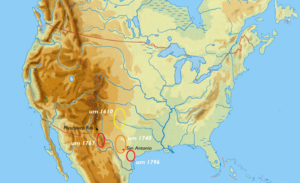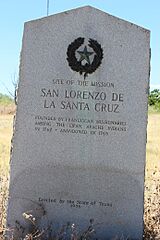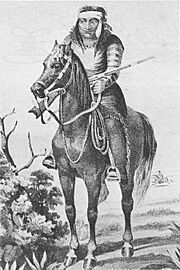Lipan Apache people facts for kids
| Total population | |
|---|---|
| U.S. Census: 1,077 (2010), self-identified 100 (SIL 1977) |
|
| Regions with significant populations | |
| United States: New Mexico, Oklahoma, Texas |
|
| Mexico: Coahuila |
|
| Languages | |
| English, Spanish, Lipan Apache | |
| Related ethnic groups | |
| other Apache peoples |
The Lipan Apache are a group of Apache people. They are an Indigenous people who have lived for hundreds of years. Their homeland was in the Southwest and Southern Plains. When Europeans and Africans first arrived, they lived in areas like New Mexico, Colorado, Oklahoma, Texas, and northern Mexico. They were known as the Apache group living furthest to the east.
Today, many descendants of the Lipan Apache live in Texas, New Mexico, Oklahoma, Arizona, and northern Mexico. Some are part of three tribes officially recognized by the U.S. government. These are the Mescalero Apache Tribe in New Mexico, the Tonkawa Tribe of Indians of Oklahoma, and the Apache Tribe of Oklahoma. The Apache Tribe of Oklahoma is also called the Kiowa Apache or Plains Apache. However, the Lipan Apache themselves are not a single federally recognized tribe. Many Lipan Apache descendants also belong to groups not officially recognized by the government.
Contents
What's in a Name?

The name "Lipan" comes from a Spanish version of what the people called themselves. They called themselves Łipa-į́ Ndé or Lépai-Ndé. This means "Light Gray People." This name might relate to their journeys and where they lived. One of the first times the Lipan Apache were written about, they were called Ypandes.
A writer named Nancy McGown Minor explained the name. She said lépai means 'the color gray' and ndé means 'the people'. So, Lipan means 'The Light Gray People'. The name "Apache" might come from the Zuni language word apachu, meaning 'enemy'. Or it could come from the Ute people, who called them Awa'tehe.
The Apache people often call themselves "Inde" or "Nde," which simply means "the people." Sometimes, the Lipan Apache are also called "Eastern Apache" or "Texas Apache."
Language of the Lipan Apache
The Lipan Apache language is a Southern Athabaskan language. It is very similar to the Jicarilla Apache language. In 1938, a language expert named Harry Hoijer observed Lipan people in South Texas speaking this language.
Sadly, by 2009, there were very few, if any, people still speaking Lipan Apache. The language is now considered almost gone or "dormant." In 1981, only a few older speakers lived on the Mescalero Apache Reservation. Today, people are working hard and raising money to bring the language back to life.
History of the Lipan Apache
The Lipan Apache and other eastern Apache groups lived in a large area. This land stretched from the Southern Great Plains to the Gulf of Mexico. They had a strong presence in what is now Texas. We don't have much archaeological evidence just for the Lipan Apache. However, some ancient pictographs (rock paintings) in Paint Rock, Texas, tell their stories. These paintings show their origins, special ceremonies, and heroes. These pictographs are up to 12,000 years old. Many different tribes, including the Lipan Apache, likely contributed to them.
Early Encounters (16th and 17th Centuries)
The ancestors of the Lipan Apache first met Europeans in 1541. This happened during the journey of Francisco Vásquez de Coronado along the Canadian River. They were still in that area when Diego de Vargas arrived in 1694. Historians believe that the Teya Indians of the Texas Panhandle may have joined the Lipan people.
By 1608, the Lipan Apache learned to use horses from the Spanish. This helped them travel widely and live a nomadic life. They became skilled horse riders. During the 1600s, Spanish settlers sometimes captured Apache people and forced them to work. In 1680, a group of Lipan, called the Acho, joined the Taos Pueblo and Picuris Pueblo people. They fought against the Spanish in the Pueblo Revolt.
In 1684, Spanish colonists built Mission San Francisco de los Julimes in Texas. It was for the Jumano, Julime, and nearby tribes. These tribes shared the peyote ceremony with the Tonkawa and Lipan. Later, the Lipan shared it with other Apache groups and the Comanches.
Life in the 18th Century
By 1700, the Lipan had settled across southern Texas and into Coahuila, Mexico. They still grew crops like pumpkins, corn, and beans. They also grew watermelons, which came from Africa. A French explorer, Bénard de La Harpe, met the Lipan Apache in Oklahoma in 1719.
The Lipan Apache were first mentioned in Spanish records in 1718. They were noted for raiding Spanish settlements in San Antonio. They often raided Spanish supply wagons traveling to San Antonio.
In 1749, two Lipan Apache chiefs and other Apache leaders signed an early peace treaty with Spain in San Antonio. Some Lipan Apache settled northwest of San Antonio in the mid-1700s.
Spanish colonists built forts and missions near Lipan settlements. A mission on the San Sabá River was built in 1757. But the Comanche and Wichita tribes destroyed it. In the same year, the Lipan Apache fought the Hasinais, a group of Caddo people. The Lipan joined a Spanish journey against the Wichita and Comanche in 1759. However, they were defeated in the Battle of the Twin Villages. Other missions for the Lipan were also destroyed by the Comanche in 1767.
By 1767, all Lipan people had left the Spanish missions. That same year, the Marquis of Rubí began a harsh policy against the Lipan. This happened after a smallpox epidemic in 1764 had greatly reduced the tribe's population.
Challenges in the 19th Century
In the early 1800s, Lipan Apache mostly lived in south and west Texas. Their lands stretched from the Colorado River to the Gulf of Mexico. They were allies with the Tonkawa people during this time. To fight against their enemies, the Comanche and the Mexicans, the Lipan Apache joined forces with the Republic of Texas in the 1830s. They helped the Texas Militia as scouts during the Texas Revolution (1835–36).
After Texas became a state, it had many war debts. To raise money, Texas sold land, leaving almost no land for American Indians. In 1854, Texas created the Brazos Reservation. About 2,000 people from tribes like the Caddo and Tonkawa lived there. But by 1859, these tribes were forced to move to Indian Territory (now Oklahoma).
In 1855, some Lipan Apache joined the Brazos Reservation. However, most did not. Some went to live with the Plains Apache in Oklahoma. Others joined the Mescalero Apache in New Mexico. Many also sought safety in Mexico.
In 1869, Mexican soldiers were sent to Zaragosa. Their goal was to remove the Lipan Apache, who were blamed for causing trouble. Chief Magoosh (born around 1830) led his group from Texas. They joined the Mescalero Apache on the Mescalero Reservation in 1870. Soldiers attacked many Lipan camps. Survivors fled to the Mescaleros in New Mexico. From 1875 to 1876, the United States Army worked with the Mexican Army. They aimed to remove the Lipan from Coahuila in northern Mexico. In 1879, a group of 17 Lipan settled near Fort Griffin, Texas. But in 1884, they were forced to move to Indian Territory. There, they joined the Tonkawa.
In 1891, the Lipans talked with Mexican President Porfirio Díaz. They wanted to keep their tribal land in Zaragosa. This agreement lasted about 12 years. Then, they were forced to leave Zaragosa after they did not want to join the Mexican Army.
The 20th Century
In October 1903, 19 Lipan Apaches who had fled Texas into Coahuila were taken to northwest Chihuahua. They were held there until 1905. After their release, they went to the Mescalero Reservation.
Lipan Apache Groups
The Lipan Apache were formed from several eastern Apache groups. These groups came together to protect themselves from the Comanche and their allies. By about 1720, the Comanche pushed the Lipan Apache out of the southern Great Plains. By the early 1700s, the Lipan were divided into different regional groups. These included the Forest Lipan, the Plains Lipan, and groups living mainly in northern Mexico (Mexican Lipan).
Forest Lipan Division
These groups lived in the forest areas.
- Sun Otter band (Tcheshä’ⁿ): They lived from San Antonio, Texas, south to the Rio Grande.
- High-Beaked Moccasin band (Kóke metcheskó lähäⁿ): They lived south of San Antonio and into northern Mexico.
- Canneci Tinné: This was the easternmost Apache group. Their land included parts of present-day Louisiana.
Plains Lipan Division
These groups lived on the open plains.
- Fire or Camp Circle band (Ndáwe ɣóhäⁿ): They lived west and southwest of Fort Griffin, from the San Saba River to the Rio Grande River.
- Little Breech-clout band (Tchaⁿshka ózhäyeⁿ): They lived along the lower Pecos River in Texas.
- Prairie Men (Kó'l kukä'ⁿ): They lived west of Fort Griffin along the upper Colorado and Concho Rivers. They also traveled west of the Pecos River.
Mexican Lipan Groups
These groups lived mainly in Mexico.
- Big Water band (Kú’ne tsá): In the mid-1700s, this group moved from San Antonio to northern Coahuila, Mexico. They lived along the Escondido and San Rodrigo Rivers.
- Painted Wood People (Tsésh ke shénde): They lived in Lavón, Coahuila, Mexico.
Population Numbers
In 1690, a researcher named James Mooney thought there were about 500 Lipan Apache. A missionary priest, Friar Diego Ximenez, estimated the Lipan population to be around 5,000 in 1762. He estimated 3,000 in 1763 and 4,000 in 1764. In 1778, Spanish military leaders thought there were 5,000 Lipan men. By 1820, a Mexican official estimated about 700 Lipans in Texas. Between 1845 and 1855, other researchers estimated the population was between 500 and 1,000. The 1910 U.S. census listed 28 Lipan Apache people.
The Lipan Apache Today (21st Century)
Descendants of the Lipan Apache are part of three tribes officially recognized by the U.S. government:
- Mescalero Apache Tribe in New Mexico
- Tonkawa Tribe in Oklahoma
- Apache Tribe of Oklahoma
The Lipan Apache do not have their own separate federally recognized tribe.
Several groups in Texas and Louisiana say they have Lipan Apache heritage. These groups are not federally recognized.
Louisiana
- Choctaw-Apache Tribe of Ebarb, also known as the Choctaw-Apache Community of Ebarb, in Zwolle, Louisiana
- Canneci Tinné Apache Tribe, in Carencro, Louisiana
Texas
- Apache Council of Texas in Alice, Texas
- Cuelgahen Nde Lipan Apache of Texas in Three Rivers, Texas
- Lipan Apache Band of Texas in Brackettville, Texas
- Lipan Apache Nation of Texas, also known as the Kuné Tsa Nde Band of the Lipan Apache Nation of Texas, in San Antonio, Texas
- Lipan Apache Tribe of Texas in McAllen, Texas
The State of Louisiana officially recognized the Choctaw-Apache Community of Ebarb in 1978.
Texas does not currently have a formal way to recognize tribes. However, state recognition can happen in different ways. On March 18, 2009, the Texas Legislature passed resolutions (Senate Resolution 438 and House Resolution 812). These resolutions recognized the Lipan Apache Tribe of Texas as a historical tribe. They also praised the tribe's contributions to the state. In 2019, the Texas Legislature passed more resolutions (Senate Concurrent Resolution No. 61 and House Concurrent Resolution No. 171). These resolutions confirmed that the Lipan Apache Tribe of Texas is the modern-day group of a proud people. They have lived in Texas and northern Mexico for over 300 years. The resolutions also praised the Tribe for its valuable contributions. The Senate, House, and the Governor all signed these resolutions.
Texas senate bills for formal state recognition of the Lipan Apache Tribe of Texas were introduced in 2021 and in 2022. Both bills did not pass in committee.
The Lipan Apache Band of Texas was honored by the Texas state legislator in 2011 through House Resolution 540.
In December 2024, the Choctaw-Apache Community of Ebarb and the Lipan Apache Tribe of Texas became registered members of the National Congress of American Indians (NCAI). The NCAI is an organization for American Indian and Alaska Native tribal governments.
Important Lipan Apache Chiefs
Here are some important chiefs and when they were active.
- Bigotes (meaning 'Mustached One') (mid-1700s): In 1751, he moved his group from Texas into Coahuila, Mexico. They lived along the Rio Escondido and Rio San Rodrigo.
- Poca Ropa (meaning 'few or scant clothes') (around 1750 – 1790): He was Chief of the Little Breech-clout band along the lower Pecos River.
- Cavezon/el Gran Cavezon (meaning 'The Big Head') (around 1760 – 1790): He was Chief of the Fire/Camp Circle band. They lived along the San Saba River towards the upper Nueces River.
- Yolcha/Yolcna Pocarropa (around 1822 – 1828): He was Chief of several groups of the Little Breech-clout band in western Texas. He was the grandson of Poca Ropa. He moved his group to the Laredo and lower Rio Grande region in the late 1820s.
- Cuelgas de Castro (around 1821 – 1842): He was Chief of the Sun Otter band. Their territory was near San Antonio and across the Rio Grande in Tamaulipas. He was important in dealings between the Republic of Texas and the Lipan Apache. He was an ally of chiefs Flacco and Yolcha Pocarropa.
- Flacco (around 1821 – 1843): He was Chief of the High-Beaked Moccasin band east of San Antonio. He often helped Texas Militia units. He was a friend of Sam Houston, who was President of the Republic of Texas.
- Magoosh (Ma’uish) (around 1850 – 1900): He was Chief of the Sun Otter band in southeastern Texas. Due to a serious illness, one part of his group went to Zaragosa in Coahuila. The other part of Magoosh's group found safety with the Mescalero Apache. They joined them on the Mescalero Reservation in 1870.
See also
 In Spanish: Lipán para niños
In Spanish: Lipán para niños




